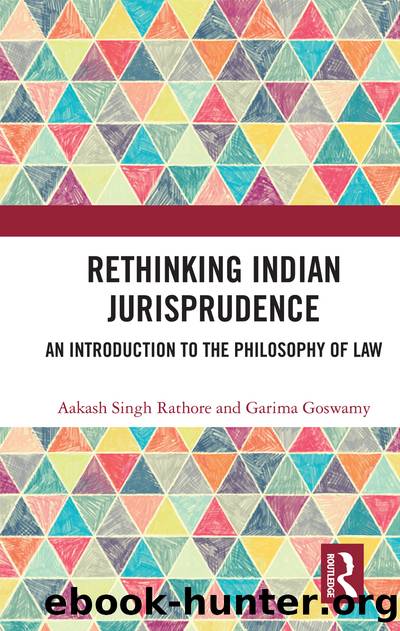Rethinking Indian Jurisprudence by Aakash Singh Rathore Garima Goswamy & Garima Goswamy

Author:Aakash Singh Rathore,Garima Goswamy & Garima Goswamy
Language: eng
Format: epub
Publisher: Taylor & Francis (CAM)
Published: 2018-01-18T00:00:00+00:00
Disrupting the link between law and justice: the sedition trial
Gandhi transcended mere ‘creativity’ and engaged the ‘radical’ potential of law when he courted prosecution for sedition. His work in South Africa in particular sees Gandhi toying with the numerous possibilities of law. As early as 1907 Gandhi experimented with a new idea – to not offer a defence, to accept guilt, and to ask for the maximum punishment. He underwent three trials between 1907 and 1913.
From these three trials in South Africa one can make two observations. First, the response to Gandhi as an accused in court changes from the first trial in 1907 in which Gandhi is not allowed to speak, to the trial in 1908 when there is a visible softening of the judge as he refused to pass the highest penalty. By the time of the third trial in 1913, Gandhi’s reputation seems to have been established; the judge observed that ‘it is his painful duty to pass sentence upon the conduct of a gentleman like Mr. Gandhi.’ In the contest between the judge and the prisoner, the prisoner seems to have appropriated some part of the moral authority which one associates with the notion of justice. The link between law and justice seems to have been shaken, as suggested by the apologetic language of the judge. Second, Gandhi was able to supplement the silent language of protest with the eloquence of speech. He converted the courtroom into another forum for the ventilation of the grievances of the Indian community. He also began to articulate his philosophy that ‘without suffering it was not possible for them to get their grievance redressed.’
The South African trials are in effect test runs for the sedition trial in Ahmedabad in 1922. Gandhi was tried under Section 124-A of the IPC on the charge of ‘exciting disaffection towards the government established by law in India’. Drawing from his South African experience, Gandhi again pleaded guilty and made a statement. The statement is an eloquent summary of why ‘a staunch loyalist and co-operator should become an uncompromising disaffectionist and non-co-operator’ (Gandhi, 1922: 241). Gandhi challenged the legal system, arguing that it bears no inherent connection with justice. Gandhi concluded his remarks by summarizing why he is a disaffectionist, before seeking the ‘severest penalty’. His statement is a powerful indictment of the entire colonial system. Gandhi succeeded in disrupting the link between law and justice; after Gandhi’s speech, the colonial state’s legitimacy was disrupted, and the moral centre cleaved towards Gandhi.
In the sedition trial, Gandhi converted the charge against him of ‘causing disaffection’ into a powerful statement on why ‘exciting disaffection’ against the government was ‘the highest duty of the citizen’. In short, as Sudipta Kaviraj observes, ‘the trial of the rebel was turned into something that appeared more like a trial of the State.’4 In the trial of the State what is contested most seriously is the link of the State to justice. As Gandhi demonstrates in eloquent prose, not only has the
Download
This site does not store any files on its server. We only index and link to content provided by other sites. Please contact the content providers to delete copyright contents if any and email us, we'll remove relevant links or contents immediately.
| Anthropology | Archaeology |
| Philosophy | Politics & Government |
| Social Sciences | Sociology |
| Women's Studies |
Cecilia; Or, Memoirs of an Heiress — Volume 1 by Fanny Burney(31333)
Cecilia; Or, Memoirs of an Heiress — Volume 3 by Fanny Burney(30934)
Cecilia; Or, Memoirs of an Heiress — Volume 2 by Fanny Burney(30889)
The Great Music City by Andrea Baker(21313)
We're Going to Need More Wine by Gabrielle Union(18073)
Bombshells: Glamour Girls of a Lifetime by Sullivan Steve(13108)
Pimp by Iceberg Slim(12931)
All the Missing Girls by Megan Miranda(12748)
Fifty Shades Freed by E L James(12451)
Norse Mythology by Gaiman Neil(11883)
Talking to Strangers by Malcolm Gladwell(11877)
Crazy Rich Asians by Kevin Kwan(8349)
Mindhunter: Inside the FBI's Elite Serial Crime Unit by John E. Douglas & Mark Olshaker(7834)
The Lost Art of Listening by Michael P. Nichols(6474)
Enlightenment Now: The Case for Reason, Science, Humanism, and Progress by Steven Pinker(6405)
Bad Blood by John Carreyrou(5769)
The Four Agreements by Don Miguel Ruiz(5511)
Weapons of Math Destruction by Cathy O'Neil(5037)
We Need to Talk by Celeste Headlee(4869)
